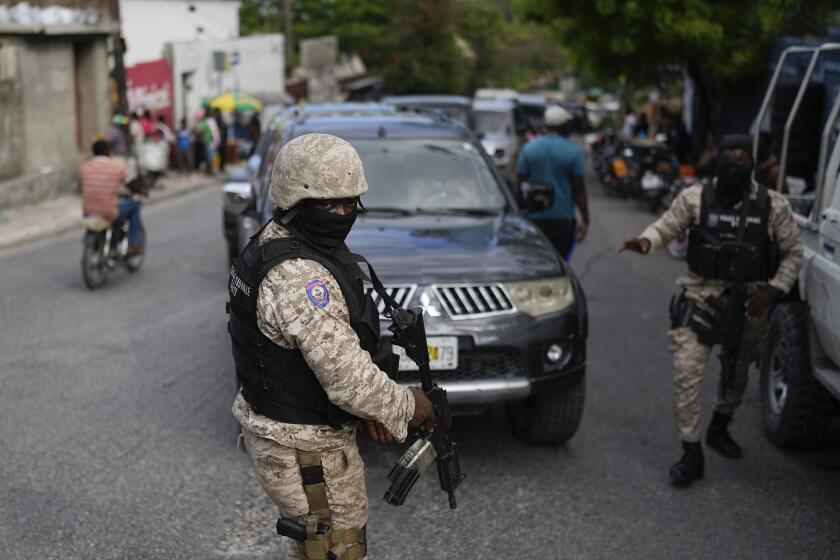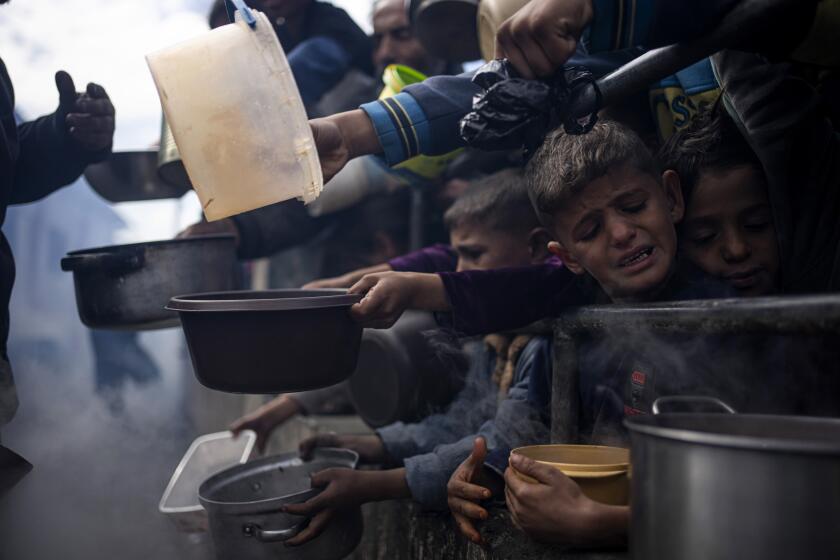Critic’s Notebook: Al Jazeera English leads the way in news coverage from Egypt
Would the American Revolution have been fought sooner if colonists had tweeted from the scene of the Boston Massacre? Would Madame Guillotine have survived for more than a day if there had been live streaming from the Place de la Revolution?
Has Al Jazeera English changed or simply captured the face of revolution?
Although available in fewer than 3 million American homes, the network’s bright orange banner and signature flame-shaped icon have burned themselves into international consciousness during the last week as people bend over their laptops and smart phones to watch Al Jazeera’s superlative coverage of the protests first in Tunisia and now in Egypt.
From the moments the Egyptian protest began last week, Al Jazeera English appeared to have more boots on the ground than other news outlets, walking with the demonstrators as they gathered in Cairo and Alexandria to call for an end of President Hosni Mubarak’s government. Especially in the early days of the coverage, American news outlets used Al Jazeera video and referenced its reporting with a reverence usually reserved for the BBC. Since then the 5-year-old network has dedicated itself to covering the unfolding events almost 24 hours a day.
Some American pundits have been calling this Al Jazeera’s “CNN moment,” referring to that network’s coverage of the Gulf War, which catapulted it into popularity. But it goes beyond the question of whether Al Jazeera English will finally become part of a premium cable package. Never before has civil unrest on this scale been chronicled in real time with such intimate and multi-platform ambition.
There has been little attempt at objectivity; the excitement in the journalists’ voices is barely veiled as they chronicle “the historic and unprecedented” political action in the normally “apathetic Egypt.” The early scattered protests led to tear gas and, as the Al Jazeera English announcer intoned, “the Egypt [that] activists know all too well. But [the protestors] have at least broken the fear barrier.”
Indeed, footage documenting Friday’s battle for Kasr al-Nil bridge was introduced as “The day Egyptians lost their fear,” with an overhead camera capturing the batons and tear gas cylinders of the police in their Robocop riot gear and the swelling ranks of “ordinary Egyptians” as they pushed back until the authorities retreated.
As the president shut down local television outlets and then Internet communication, Al Jazeera English used the typical network tools of wide overhead shots to show the growing numbers gathering in Cairo’s Tahrir Square in answer to the call for a Million Man March but also sent cameras darting in among the protestors. Viewers could all but smell what mass protest looks like. The satisfying snap of a waved flag, the rustle of tents being set up for the long night, the murmur of the crowd hunkering down to wait, the blue firefly glow of cellphones held aloft in the dark. Revolutionaries have never before been so precisely human.
A steady stream of on-the-street interviews with people of all ages and occupations captured individual frustration with the lack of jobs and the police state. At one point, a young woman about to speak was pushed aside by an older woman barely visible beneath her traditional head-covering who announced she was tired, tired of waiting for change, glorious and vaguely hilarious proof of a nation roused.
Neatly straddling the pedestrian and technological, Al Jazeera English has regularly cut back to the studio where journalists kept viewers up to date on the Twitter response — on Tuesday, it was revealed that a woman Al Jazeera had thought was tweeting from Cairo was actually in the U.S. although they commended her work all the same — and offering images sent in from cellphones and video cameras around the country.
Some news outlets have remarked on the role of catalyst that Al Jazeera has played in events, but the network is also doing sentry duty. Watching, it’s impossible not to believe that the knowledge of all the cameras, and the world’s eyes, have held the police back after early images of beatings and shootings fed anger in Egypt and throughout the world. Likewise, the protestors seem quite aware of the response, both nationally and internationally, to their actions, which may explain why the looting that occurred last week appears to have died down as well. On Tuesday, a giant screen was erected in Tahrir Square; it was showing Al Jazeera.
“Thank you for having this live,” one Egyptian actor told an Al Jazeera reporter. “No other networks can do this.”
The imagery of unrest and revolution are integral to virtually every nation, especially the United States. In the past, we have had to rely on our poets and painters, reporters and photographers, to capture, evoke and more than occasionally spin the nature of humanity’s great moments of rebellion. The Boston Massacre, the storming of the Bastille, the Easter Rising, Gandhi’s Salt Satyagraha, the protests in Tiananmen Square were all chronicled and described, some captured in part on film, before being distilled into a few time-burnished images, pictures or words that become shorthand for incalculable change.
No doubt this will happen with the protests in Tunisia and Egypt as well, but instead of the big moments, the hangings in effigy, the tear gas and deaths, this particular protest may be most remembered for Al Jazeera’s ability to capture the actual footfalls of revolution. The protestors bowing their heads against the water cannons; the bearded young men in T-shirts and old women in head scarves holding the same signs, the hours of silence preceding Tuesday’s mass demonstrations, the Egyptian national anthem rising in the dark from Cairo and Alexandria as millions sat and stood and refused to leave until their president stepped down.
Ironically, Al Jazeera’s technologically amped-up coverage proves the lasting truth about revolution — in the end, it’s not about words or images at all. In the end, it’s about people standing side by side, refusing to move anywhere but forward.
More to Read
Start your day right
Sign up for Essential California for news, features and recommendations from the L.A. Times and beyond in your inbox six days a week.
You may occasionally receive promotional content from the Los Angeles Times.







